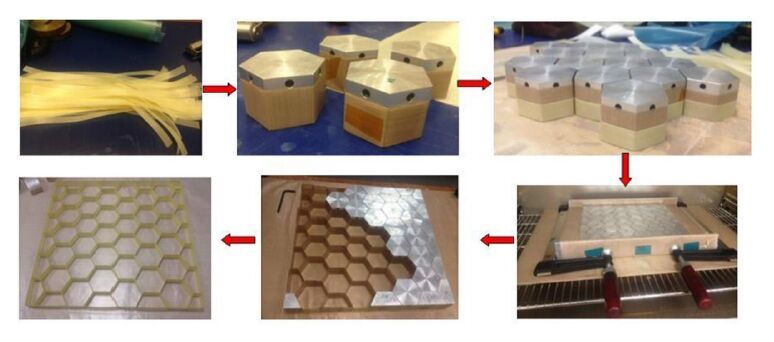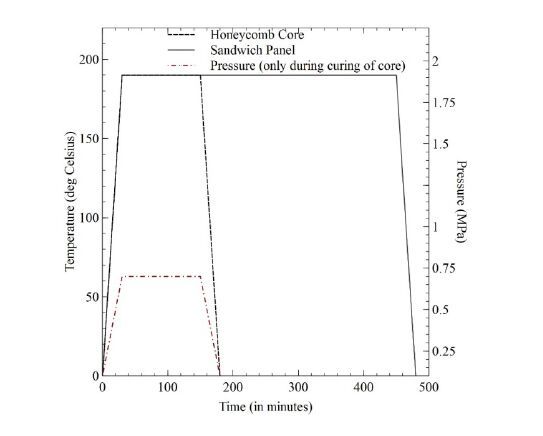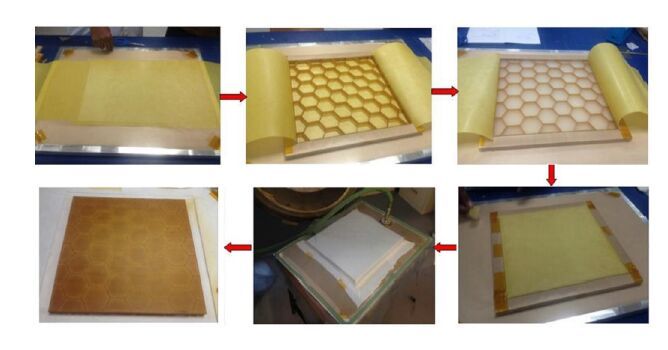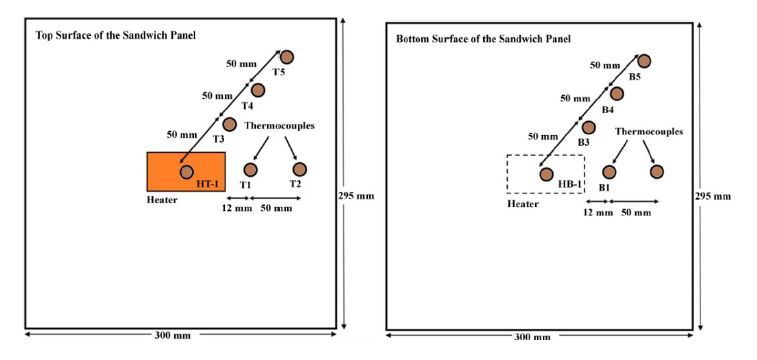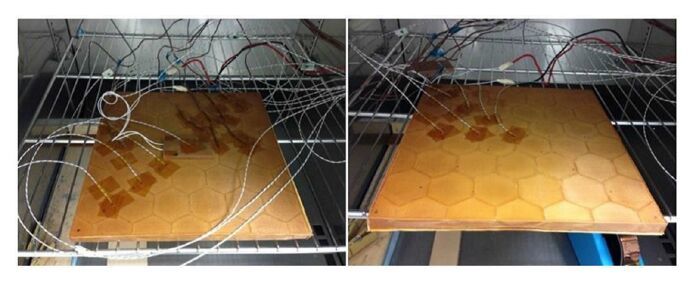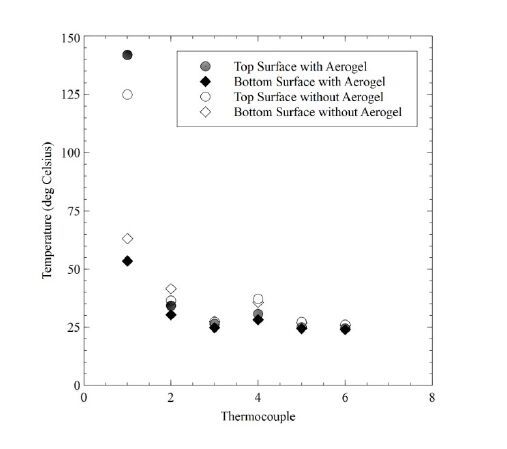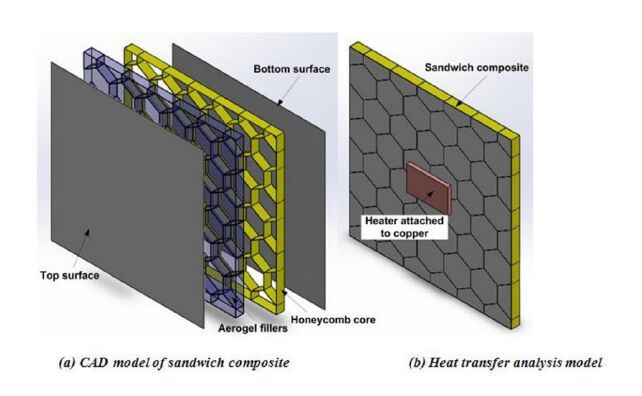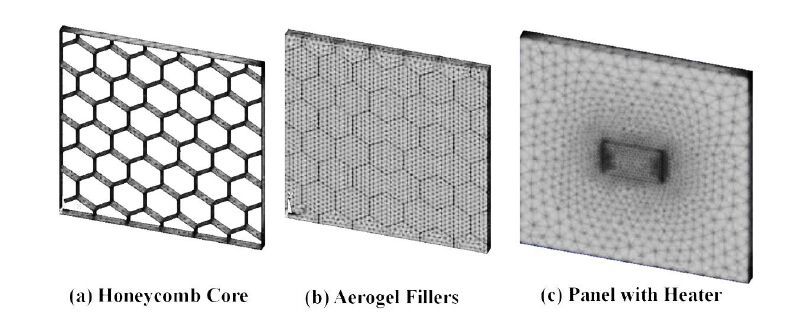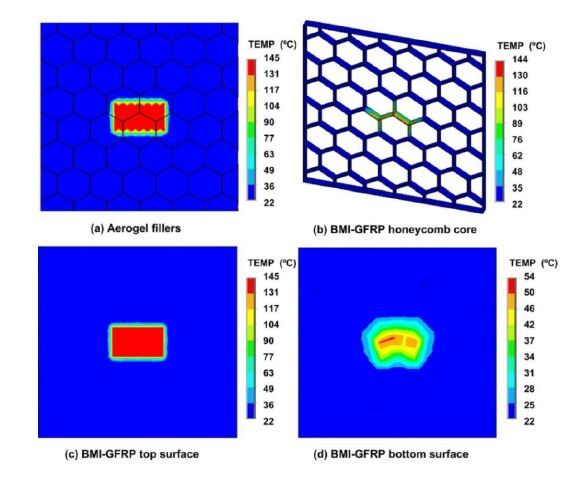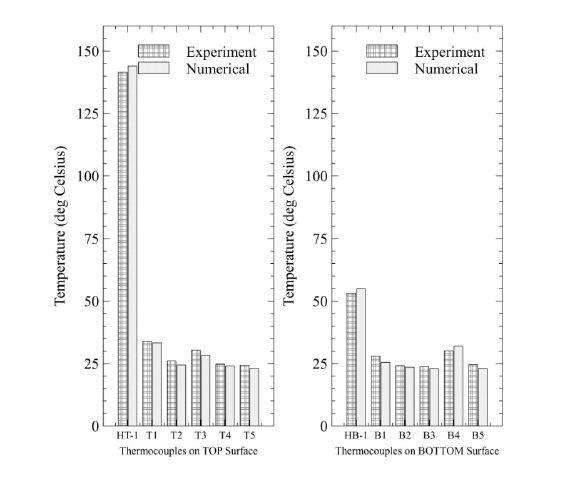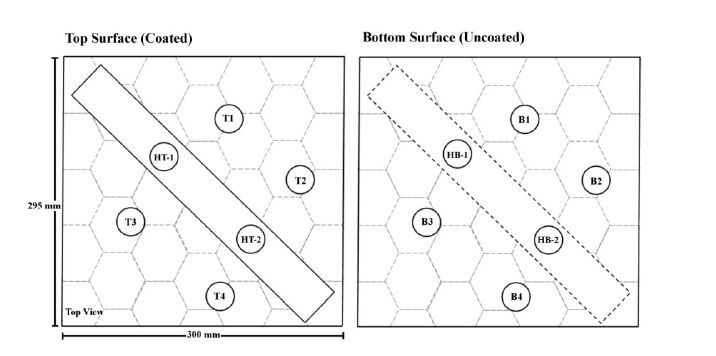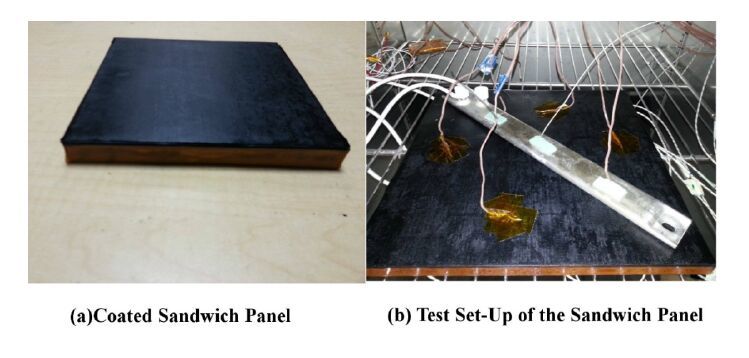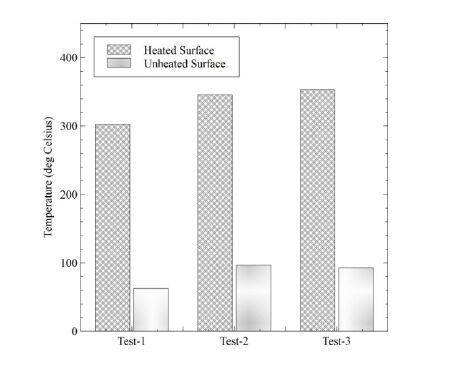Abbreviations
| BMI | Bismaleimide |
| GFRP | Glass Fibre Reinforced Polymer |
| Glass/BMI | Bismaleimide reinforced with glass fibres |
| HT-1 | Thermocouple on the heater on the top surface |
| HB-1 | Thermocouple on the bottom surface directly under the heated zone |
| T1, T2, T3, T4, T5 | Thermocouples on the top face-sheet |
| B1, B2, B3, B4, B5 | Thermocouples on the bottom face-sheet |
| Φq | Heat Flux |
| hc | Heat convection co-efficient |
1. Introduction
Many industries are on the lookout for lighter and stronger materials that will replace traditional structural materials like engineering metal alloys. Composites have gained a lot of attention over the past couple of decades, due to their high specific strength, stiffness, toughness, and low density [1]. Composites experience low or no corrosion (although they can be degraded by hygro-thermal exposure), better fatigue behaviour, and can be fabricated net-shape. As a result, using composites as structural materials in aircrafts leads to weight savings of 20-25% [2].
Sandwich composites, a special category of composites fabricated by having a thick lightweight core sandwiched between two thin face sheets, are one among the various ways in which composites are used as structural materials. Face sheets are generally made of high-stiffness composites bonded to a thick core which is usually made of a low density material. The main function of the core is to increase the distance between the two face sheets thereby giving the sandwich composite a high ratio of flexural stiffness to weight. The core also helps resist transverse shear loads, lowers lateral deformation, increases buckling resistance, provides fracture toughness and has higher natural frequencies [3,4,5].
A lot of research is being carried out to study the properties of sandwich structures. Analytical formulae for calculating in-plane and out-of-plane stiffness for honeycomb cores were published by Gibson & Ashby [6]. Mujika et al. [7] studied the out-of-plane shear modulus of honeycomb cores experimentally, analytically and through FEM. Foo et al. [8] investigated the mechanical properties of bare Nomex honeycomb core. The effect of honeycomb core on the strength, stiffness and initiation of damage on a sandwich panel under static or low-velocity impacts have been investigated [9,10,11]. Studies on the parametric effects of core geometry and indenter diameter on the compressive strength of honeycomb core sandwich panels were carried out by Czabaj et al. [12]. The static and the dynamic properties of sandwich structures were found to improve by well-chosen honeycomb architecture with additional polymeric foam filling [13]. It was also observed that reinforcing the honeycomb core with foam reduced the local modes of vibration and increased the overall flexural rigidity. The stiffness of sandwich panels under out-of-plane loading conditions depended on the density of the honeycomb core [14]. Increasing the web height and thickness, decreasing the web spacing and using thicker face sheets improved the bending strength and initial bending stiffness of a foam-GFRP core [15]. Structural rigidity and factor of safety were improved for the body of an electric vehicle by using sandwich panels [16]. The honeycomb cell size, cell wall thickness and cell height did not affect the impact penetration resistance of the sandwich panels, but rather the impact energy was found mostly to be absorbed by the face-sheets [17]. Xiong et al. [18] carried out investigations on mechanical properties and failure response of 3D honeycomb cores and formed failure mechanism maps to predict the failure modes with different structural parameters. Wang et al. [19] manufactured 2D truss core CFRP sandwich panel and studied its mechanical behaviour. Investigations have also been carried out on manufacturing of honeycomb cores made of vinylester matrix reinforced with jute fabric by compression moulding by Stocchi et al. [20].
Sandwich structures are not new to aircraft industry. Bitzer [21] in his 1992 overview of honeycomb cores stated that every two or more aircraft engines in the western world employs some honeycomb sandwich core; the Boeing 757/767 has honeycomb sandwich on about 46% of its wetted surface. The cylindrical fuselage shell of the Boeing 747 is primarily Nomex honeycomb sandwich and sandwich structures have also been used for the floors, side-panels, overhead bins and the ceiling [3]. Nomex honeycomb is also used in the Beech Starship which is almost entirely made using honeycomb with either carbon or Kevlar face sheets [22]. The Voyager aircraft had a 6.35 mm thick Nomex honeycomb with two plies of carbon prepreg as face sheets. This restricted the weight of the aircraft structure to 426 kg which was about 9% of its total take-off weight (4881 kg). Honeycombs are also used in helicopter rotor blades, space shuttle and in satellite structures. Sandwich structures are also used in boat hulls, canoes, skies, race cars, sailboats, sporting goods etc. A stealth-optimized graphite/epoxy vessel, YP2000 Visby, developed by the Royal Swedish navy primarily uses sandwich construction [23]. Honeycomb sandwich structures can further be used as energy absorbers, thermal barriers, acoustic barriers, and for radiofrequency shielding. Gu et al. [24] investigated the heat transfer in sandwich cores of different architectures - hexagonal, square and triangle. Their study showed that the best heat transfer efficiency was achievable byhexagonal structures.
The current work is looking to enhance the effectivity of sandwich composites by adding more functionality to them. The aim is to investigate the effectiveness of customized sandwich panels with their honeycomb core filled with translucent silica aerogel granules as thermal barriers. Experimental and numerical heat transfer studies are carried out to study the temperature distribution through the sandwich panels. The developed panels could potentially be employed as camp shelters for hot and humid climate, protective gearing against heat, insulation in space and space-crafts, etc. To this effect, the paper provides a manufacturing technique for customizing the honeycomb core made up of the same material as the face sheets. The sandwich panels were manufactured from Bismaleimide resin system reinforced with glass fibres (Glass/BMI). Cells of the honeycomb core are then filled with specific amount of silica aerogel granules to increase the heat transfer capabilities of the panel. Silica aerogel is an excellent insulator and contains about 99.8% air and 0.2% silica dioxide. An experimental study conducted earlier on CFRP sandwich panels filled with aerogel induced a temperature difference of 85 °C between the two face sheets [25]. The temperature difference was mainly attributed to the presence of aerogel granules in the sandwich panel. The operational temperature of the panels is pushed up by the application of high temperature coatings.
2. Materials and Method
The specification of the Glass/BMI prepreg and the aerogel granules used as provided by the manufacturer [26,27] are given in Tables 1 and 2 respectively.
Table 1.Specification of bismaleimide GFRP [26]
| Product Type
|
HTM® High Temperature BMI Matrix System
|
| Prepreg Thickness, 1 Ply
|
0.135 mm
|
| Cured Ply Thickness, 1 Ply
|
0.131 mm (average based on 4 plies)
|
| Resin Content
|
30 %
|
| Thermal Conductivity
|
0.6, 0.6, 0.25 W/mK
|
| Prepreg Density
|
1240 kg/m3
|
| Supplier
|
Advanced Composites Group (UMECO), UK
|
Table 2.Specification of aerogel [27]
| Product Type
|
Nanogel™ Translucent Aerogel
|
| Particle Size
|
0.5-4.0 mm
|
| Pore Diameter
|
20 nm
|
| Porosity
|
>90%
|
| Bulk Density
|
90-100 kg/m3
|
| Surface Chemistry
|
Fully Hydrophobic
|
| Thermal Conductivity
|
0.018 W/mK at 25 °C
|
| Specific Heat Capacity
|
0.7-1.15 kJ/kg
|
| Flash/ Self Ignition Point
|
395 °C
|
| Supplier
|
Cabot Corporation, Germany
|
|
2.1. Design of Sandwich Panels
It was decided to custom-design and to fabricate the honeycomb core using Glass/BMI prepregs, which was also to be used for the face sheets of the sandwich panel.
The rationale was to reduce mismatch between the core and the face sheet materials as well as form the honeycomb cells as large as possible without compromising the structural performance. Parametric analysis carried out on the honeycomb cell geometry (cell wall length and cell thickness) showed that as the cell size reduces, the cross-sectional area of the GFRP in the sandwich panel increases, leading to an increase in the GFRP-Aerogel ratio. This also results in an increase not only in weight and the material usage but also in the thermal conductivity of the entire sandwich panel reducing its thermal insulation effect.
It was envisaged that the fabrication of the sandwich panels will be a two-step process. The first is to lay the honeycomb core and partially cure it. Subsequently, use this core to complete the sandwich panel fabrication including full curing.
Before fabricating the sandwich panel a brief study was conducted to optimize a way to utilize the hexagonal cells of the honeycomb core. The results are shown in Table 3. It was decided that the best way to fill the hexagonal cells was to completely fill the cells with the aerogel granules as it would provide structural support to the two face-sheets of the sandwich panels and also help accomplish the intended use of the panel as an effective thermal barrier.
Table 3.Schematic of filling type in hexagonal cell
| Type of Filling in the Hexagonal Cell
|
Schematic Layout
|
Observations
|
| Only air filled core
|
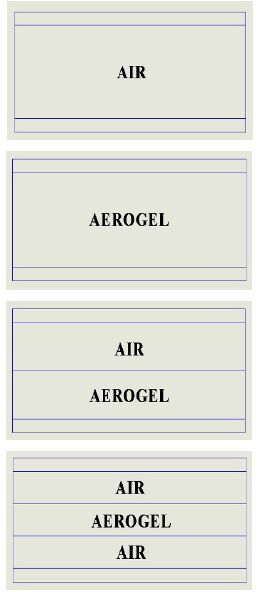
|
Air offers low thermal conductivity. Shrinkage of the top and bottom surfaces if the sandwich panel after curing.
|
| Fully aerogel filled core
|
Insignificant shrinkage.
Structurally strong compared to air filled sandwich panel.
|
| Air-Aerogel filled core
|
Material saving. But, tough to fabricate. The GFRP face sheet on the air side collapsed partially after curing.
|
| Air-Aerogel-Air filled core
|
Good material saving. But very tough to fabricate. Face sheets and the inner layers collapsed after curing.
|
2.2. Fabrication of Sandwich Panels
Glass/BMI prepregs were used to fabricate flat sandwich panels measuring 295 mm × 300 mm. The fabrication of the honeycomb core is shown in Figure 1. The honeycomb core was fabricated using specially designed aluminium blocks. These aluminium blocks when assembled together formed the entire honeycomb core. Each aluminium block was first wrapped with a non-porous peel ply so that the prepreg does not stick to the blocks during curing. The aluminium blocks were then wrapped twice with strips of prepreg. As the core had to have a thickness of 15 mm the prepreg was cut into 15 mm width strips. Once all the aluminium blocks were wrapped, they were assembled in position required to form the honeycomb core.
The fabrication set up was then cured in the autoclave for 3 hours at 190 °C with a pressure of 7 bar. On completion of the cure, the aluminium blocks were carefully removed leaving behind the fabricated honeycomb core. The cure cycle used for the core is shown in Figure 2.
The next step in the fabrication procedure was to add the bottom and top face sheets. The bottom face sheet was first laid in. Aerogel granules were then filled into the hexagonal cells. Once all the cells were filled, the entire panel was covered with top face sheet layers. The panel was then vacuum bagged and fully cured in an autoclave at 190 °C for 8 hours. The fabrication steps are shown in Figure 3.
3. Results and Discussion
The fabricated aerogel-filled sandwich panels were studied to assess their thermal barrier performance. Heat transfer experiments were conducted to obtain the temperature distribution through the flat sandwich panel. A localized heat source was mounted on the top surface of the sandwich panel while the temperature distribution on the top and bottom surfaces of the panel was measured with the help of thermocouples. The thermocouples were strategically placed at different locations on both the surfaces for determining the through thickness heat transfer.
3.1. Experimental Set-up for Tests below 150 °C
The first set of tests was carried out using a 25 W heater mat measuring 75 mm × 45 mm. The heater mat was sandwiched between two copper plates and acted as the localized heat source. Type-T, glass fibre insulated thermocouples were attached to the top and bottom face sheets at different locations as shown in Figure 4.
The points for the thermocouple placement were decided by quadrant symmetry of the panel. The thermocouples were distributed in the top-right quadrant, and due to symmetry, the temperature distribution is expected to be similar in the remaining 3 quadrants. Additional thermocouples were mounted at certain locations to verify this. Thermocouple, HT-1, was mounted on the heat source while thermocouple, HB-1, was attached to bottom surface right below HT-1. The thermocouples were connected to a data-logger and the entire setup was placed on a wooden plank inside an Environmental Test Chamber (Thermotron) to maintain constant exterior temperature. The temperature of the Environmental Test Chamber was maintained at room temperature (25 °C). The heater was switched on and allowed to run till the temperatures reached steady state values (the thermocouple reading varied less than 0.5 °C per minute). The experimental setup is shown in Figure 5. In Figure 5, it may be seen that extra thermocouples were placed in the bottom left quadrant. These thermocouples were placed to validate the quadrant symmetry, but the temperature measurements made with the thermocouples in the top-right quadrant (as shown in the schematic, Figure 4) were only considered.
3.2. Experimental Studies on Aerogel-filled Sandwich Panel
Heat transfer tests were conducted on 295 mm × 300 mm aerogel-filled flat Glass/BMI sandwich panels of 15 mm thickness. When the maximum temperature on the top surface around the localized heat source was about 142 °C the temperature on the bottom surface was about 53.5 °C, translating to 62% heat loss through the thickness of the sandwich panel. This amount of heat loss may be attributed to the presence of aerogel in the honeycomb core. It can also be seen that the area of the panel away from the heated zone is not affected by the heat source, indicating that the heat is largely restricted to the heated zone.
In order to quantify the contribution of the aerogel towards providing heat insulation, the same tests were carried out on a panel without aerogel. A comparison between panels with and without aerogel is shown in Figure 6, while the percentage difference in top and bottom surfaces for the two panels is given in Table 4. It can be seen that for a maximum temperature of 124.9 °C on the top heated surface, the bottom surface temperature was 63.1 °C. This brought the heat loss to about 49.5% which was approximately 12.8% less than for the panel filled with aerogel granules. The results clearly indicate the effectiveness of aerogels as thermal barriers.
Table 4.Temperature gradient and percentage difference between each point on the sandwich panels
|
Aerogel-Filled Sandwich Panel
|
| Temperature Measurement
|
Along the normal
(Ref Fig.4)
|
Along the diagonal
(Ref Fig.4)
|
| Top Surface
|
Thermocouple
|
HT-1
|
T1
|
T2
|
HT-1
|
T3
|
T4
|
T5
|
| Temperature Gradient ( °C/mm)
|
-
|
−9.0
|
−0.2
|
-
|
−2.2
|
−0.1
|
0.0
|
| Bottom Surface
|
Thermocouple
|
HB-1
|
B1
|
B2
|
HB-1
|
B3
|
B4
|
B5
|
| Temperature Gradient ( °C/mm)
|
-
|
−1.9
|
−0.1
|
-
|
−0.5
|
−0.1
|
0.0
|
| Percentage Difference in Top and Bottom Surface Temperature (%)
|
62
|
11
|
6
|
62
|
8
|
2
|
2
|
|
Air-Filled Sandwich Panel
|
| Temperature Measurement
|
Along the normal
(Ref Fig.4)
|
Along the diagonal
(Ref Fig.4)
|
| Top Surface
|
Thermocouple
|
HT-1
|
T1
|
T2
|
HT-1
|
T3
|
T4
|
T5
|
| Temperature Gradient ( °C/mm)
|
-
|
−7.4
|
−0.2
|
-
|
−1.8
|
−0.2
|
0.0
|
| Bottom Surface
|
Thermocouple
|
HB-1
|
B1
|
B2
|
HB-1
|
B3
|
B4
|
B5
|
| Temperature Gradient ( °C/mm)
|
-
|
−1.8
|
−0.3
|
-
|
−0.6
|
−0.2
|
0.0
|
| Percentage Difference in Top and Bottom Surface Temperature (%)
|
49
|
−14
|
-1
|
49
|
4
|
1
|
1
|
For the heat transfer studies, the bottom surface temperature was taken as the reference temperature for thermal barrier applications. Once the bottom temperature for the panel without aerogel went above the bottom temperature for the panel with aerogel, the tests were stopped. At this point, the top surface temperature of the panel without aerogel was lower than the temperature for the panel with aerogel. This implies that if the test was allowed to continue, the bottom temperature for the panel without aerogel would shoot up beyond the desired limit.
It may be seen from Figure 6 that, thermocouples B1 and B2 on the bottom face-sheet of the air-filled sandwich panel show higher temperature readings than the corresponding points on the top surface. This could possibly be due to circulation and convectional heat transfer of air within the core. As the air inside the core gets heated up, it starts to move inside the cell allowing more pronounced convection within the air cavity causing rise in the bottom surface temperatures. This effect was nullified when the core was filled with the aerogel.
3.3. Numerical Studies on Aerogel-filled Sandwich Panel
Numerical studies were conducted to validate the experimental temperatures. An equivalent Computer Aided Design (CAD) model was generated using SOLIDWORKS and the Finite Element (FE) analysis was carried out using ANSYS. Figures 7(a) and (b) show the CAD model of the sandwich panel for analysis. The model dimensions and the material specifications used are given in Tables 5 and 6 respectively. The properties of aerogel are adopted from the material datasheet provided by the manufacturer [27] and the thermal properties of Glass/BMI are estimated based on existing literature [29].
Table 5.Sandwich model dimensions
| Part
|
All Dimensions are in mm
|
| Length
|
Width
|
Thickness
|
| Face-sheet
|
295
|
300
|
0.25*
|
| Honeycomb Core
|
295
|
300
|
15
|
| Heater with Copper Plates
|
75
|
45
|
7.5
|
| Honeycomb Cell
|
Width of each of the six cell walls = 28 mm
|
0.25
|
| * Thickness of the face sheet includes two prepreg plies after curing. |
Table 6.Material thermal properties used for the analysis
| Materials
|
Thermal Conductivity
(W/mK)
|
Specific Heat Capacity
(J/Kg)
|
Density
(Kg/m3)
|
| Copper
|
400
|
390
|
8960
|
| Glass/BMI
|
0.6, 0.6, 0.27
|
1190
|
1211.76
|
| Aerogel granules
|
0.01-0.04
|
700-1150
|
81.83
|
|
The boundary conditions used for the simulation were:
· Heat flux, Φq = 3703 W/m2 (with, Power of Heater = 25 W and Area of the Heater = 3.38 × 10−3 m2) on the top surface of the copper plate attached to the heater mat.
· Heat convection coefficient, hc = 25 W/m2K, on the top surface of the model. For the bottom surface of the panel not exposed to direct air convection due to its contact with the wooden plank, a minimal value of 5 W/m2K was taken. In order to account for natural air convection and radiation heat transfer from the heater, the hc for heater was higher at 35 W/m2K.
· Uniform initial temperature of 22 °C corresponding to the initial temperature in the experiments, and a reference temperature of 0 °C.
The generated sandwich panel model was meshed with a total of 148,515 tetrahedral elements. Figure 8 shows the mesh of all the domains in the model.
During the simulation, the temperature evolution of two points was recorded. One was at the top surface and the other at bottom surface of the sandwich panel. The simulation took about 1.5 hours to attain steady state temperatures. Figure 9 shows the temperature distribution on the top and bottom surfaces of the aerogel filled sandwich panel. It can be seen that the highest temperature of 144 °C was locally restricted to just below the heater on the top surface while the bottom surface remained relatively cooler at about 55 °C.
3.4. Comparison of Experimental and Numerical Results of Aerogel-filled Sandwich Panels
Comparisons between the experimental and numerical results are shown in Figures 10. A close agreement between the experimental and the numerical simulation results can be seen. The maximum difference between the two is about 7%.
3.5. Thermal Studies on Aerogel-Filled Sandwich Panel with Coating
In the course of the above experiments it was found that the Glass/BMI sandwich panels started to oxidise when the temperature reached 180 °C. This was because the BMI prepreg used required post-curing to withstand higher temperatures. However, the post-curing profile for such customized aerogel sandwich panels was not available. Therefore, the maximum test temperature was limited to below 180 °C without any post-curing. In order to increase the operating temperature limits of the aerogel-filled sandwich panels and to promote their use as thermal barriers, it was decided to coat the sandwich panels with a silicone based high temperature spray. The spray paint used in this study was RJ-London HI-TEMP Spray Paint and is usually used to coat exhaust manifolds, engines, heater, boilers and other high temperature equipment. The properties of the spray paint are given in Table 7.
Table 7.Properties of RJ-HI TEMP Spray Paint [28]
| Chemical
|
Liquid Silicone
|
| Density
|
0.997 g/ml
|
| Vapour Pressure at 20 °C
|
~24.1 kPa
|
| Composition
|
Liquid Silicone 31 ± 1%; Additives 1.2%; Solvent 48 ± 1%
|
| Appearance and Odour
|
Black, Solution, Strong Odour
|
|
The paint was applied by first cleaning the sandwich panels thoroughly with a soft dry cloth to remove any dust particles settled on it. One surface of the panel was then slowly coated with the paint. Three coats of paint were applied and then the paint was allowed to dry at room temperature before testing.
Heat transfer tests were then carried out on the coated sandwich panels. The tests aimed to heat the panels beyond 180 °C. The paint was applied only on the top face of the sandwich panel, the surface on which the heat source was mounted.
For these tests, in place of the heater mat used in the earlier set-up, an AC Strip Heater (HOTWATT CS-14) was used. The heater mat was not capable of reaching temperatures above 200 °C, hence the AC Strip Heater was needed. The strip heater was controlled using a step-up transformer. The test schematic is shown in Figure 11. The strip heater was placed diagonally on the top coated surface of the sandwich panel. Again thermocouples were attached on the top as well as the bottom face sheets to measure the temperature. The coated sandwich panel is shown in Figure 12(a) and the set-up is shown in Figure 12(b). The results of the tests conducted at 300 (Test-1), 340 (Test-2), and 350 (Test-3) °C on 3 different panel specimens are shown in Figure 13. All the panels were heated for 15 minutes. The percentage difference in top and bottom surface temperatures observed over the heater zone was 79%, 72%, and 74% respectively. The last test was stopped at 350 °C. This limit was considered the upper bound for the designed material system as the silica aerogel had its flash point stated by the manufacturer at 395 °C [27].
It can be seen from Figure 13 that the coated surfaces of the sandwich panels were able to withstand temperatures of up to 350 °C. This was a significant improvement from the heat tests on uncoated sandwich panels, which would start to deteriorate and blacken at 180 °C. Another observation was that, while the coated surfaces of the sandwich panels reached 350 °C, the other uncoated surface remained relatively at a low temperature. This meant that the aerogel filler was able to effectively block the heat transfer. Additionally, Glass/ BMI also proved to be an effective heat resistant material. The area surrounding the heater zone remained relatively unaffected by the heat applied, with the surrounding face-sheet temperature remaining below 35 °C.
4. Conclusions
This work presented a methodology to fabricate aerogel-filled, honeycomb core, Glass/BMI prepreg, flat sandwich panels. Heat transfer tests conducted showed that there was a heat transmission of about 37.7% between the top heated (142 °C) surface and the bottom surface (53.5 °C). The drop in temperature was attributed to the presence of the silica aerogel in the core. The numerical analysis carried out to validate the results was in good agreement with the experimental observations.
This study succeeded in pushing the operating temperature limits of the sandwich panels by coating them with high temperature spray paint. The heat transfer experiments on the sprayed panels resulted in bearable temperature as high as 350 °C on its surface without visible degradation. In addition, the heat transmission observed through the panel thickness of 15 mm was only 27%. Thus, indicating a good thermal barrier performance.
Conflict of Interest
The authors declare that there is no conflict of interest regarding the publication of this manuscript.









 DownLoad:
DownLoad: 
